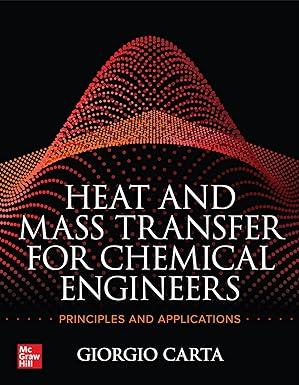Hydrogen sulfide (H 2 S) is to be removed from natural gas by absorption into amine solutions
Question:
Hydrogen sulfide (H2S) is to be removed from natural gas by absorption into amine solutions in a process known as natural gas sweetening. Experiments were done to measure the rate of absorption of pure H2S at 30°C and 1 atm absolute pressure in a laminar liquid jet apparatus using either water or an aqueous solution containing 1.0 × 10-3 mol/cm3 of an amine. The jet is 5 cm long and has a dimeter of 0.1 cm. The liquid flow rate is 4.0 cm3/s. H2S reacts with the amine according to the reaction:
The reaction is essentially infinitely fast and the physical solubility of H2S in water and in the amine solution is 8.0 × 10-5 mol/cm3 atm. The rate of absorption of H2S was determined to be 0.14 cm3/s for the water jet and 1.5 cm3/s for the amine jet. Based on these data:
(a) Determine the mass transfer coefficient and diffusivity of H2S in water.
(b) Determine the enhancement factor for absorption in the amine solution and the diffusivity of the amine.
(c) Suppose that the results are used to predict the rate of absorption in a gas-absorption column operated at 10 atm absolute pressure and 30°C at a point where the mole fraction of H2S in the gas phase is 0.01, the amine concentration in the liquid is 1.0 × 10-3 mol/cm3, and the liquid-side and gas-side mass transfer coefficients are ![]() = 6.0 × 10-4 mol/cm3 sand
= 6.0 × 10-4 mol/cm3 sand ![]() = 1.5 × 10-3 mol/cm3 s, respectively. What is the rate of absorption in mol/cm3 s for these conditions if the gas-side resistance is neglected?
= 1.5 × 10-3 mol/cm3 s, respectively. What is the rate of absorption in mol/cm3 s for these conditions if the gas-side resistance is neglected?
What is the rate of absorption in mol/cm3 s for these conditions if the gas-side resistance is considered?
Step by Step Answer:

Heat And Mass Transfer For Chemical Engineers Principles And Applications
ISBN: 9781264266678
1st Edition
Authors: Giorgio Carta





